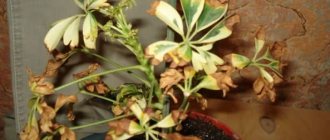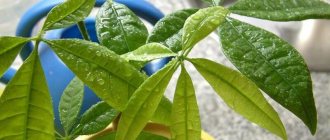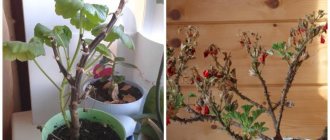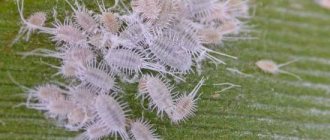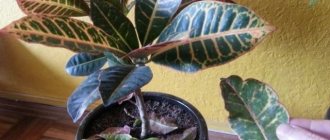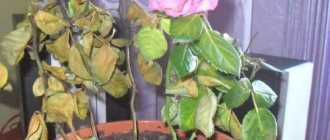Ficus March 16, 2022 3037
Home » Indoor plants » Ficus
Ficus benjamina is a wonderful plant that perfectly copes with the task of interior landscaping, and in optimal conditions it can delight with fresh greenery all year round. Ficus benjamina's leaves turn yellow and fall off; what to do is a fairly pressing question for a gardener who happens to make mistakes during the care process. Often, the problem of “baldness” can be corrected by identifying the causes of its occurrence. It is only important to intervene in a timely manner and choose the right means of helping the flower.
Description, photo
In the wild, ficus is a small bush or tree that can grow up to 10 meters. As a home crop, the tree grows from 1.5 to 2 meters. The luxurious, dense crown of the green beauty is formed by thin, erect, flowing shoots with an abundance of oval leaves. The stem is round in shape.
The leaves are smooth, with a pronounced gloss and thin veins, growing from 4 to 8 cm in length and from 2 to 4 cm in width. The foliage colors are rich in a variety of green colors: from light to very dark tones.
Where to place the ficus - the place matters!
Ficus trees are very popular among gardeners. This plant has many varieties, they look very beautiful and grow quite quickly. An adult indoor plant is 1.5–2 meters in height. Its greenery is small but dense, forming a dense, beautiful crown. One minus is that ficus trees are very capricious. And Ficus Benjamin, originally from tropical Asia, with beautiful greenery, is one of the most fastidious specimens. He is even often called the “Prince and the Pea”, because he reacts to any stress and discomfort by dropping leaves. And he has many reasons for stress.
Ficus Benjamina is a plant from the Mulberry family. The tree is the symbol of Bangkok, the capital of Thailand. In the wild it reaches a height of 25 meters. The largest representative of the species, 150 years old, grows in the Botanical Garden of Sri Lanka; its crown area is 2,500 square meters.
Of course, it is worth immediately cutting off cases when the leaves of Ficus Benjamin fall off in winter or late autumn. If their number is not large, then this is the usual preparation of the plant for winter. Each leaf only lives for three years, after which it will inevitably fall off. In this case, new greenery will appear on the tree in the spring. You should only worry if the foliage falls off in large quantities. There are many reasons for this, but in most cases the flower can be saved by providing proper care for the finicky ficus.
Benjamin is very sensitive to changes in location. Almost certainly, as soon as you bring it home from the store, it will turn yellow and bald. To avoid this if possible, choose a ficus in a store without special conditions for keeping tropical plants. Find out the conditions in which your flower grew. If it was additionally illuminated or the air was humidified, then it is worth creating similar conditions at home. Well, it’s better in the summer, this will ensure less painful transportation. Compliance with these rules will soften acclimatization for the ficus.
He is stressed not only by a radical change of location, but also by a simple rearrangement from one room to another. Therefore, before purchasing, decide on the location in advance so as not to move the pot frequently.
Benjamin loves light and warmth, so you need to choose a sunny place for him. Ideally - next to the southern window sill. Just next to it, and not on it, because direct sunlight will damage it. Diffused light is much better. Make sure that the leaves do not touch the glass. In cold weather this can freeze them, and in hot weather it can burn them.
For ficuses with variegated colors, sunlight is especially important. If it is not enough, the leaves lose the contrast of the pattern and become faded.
It is also worth protecting the flower from drafts, this is their worst enemy. Choose a place away from air currents so as not to disturb it during ventilation. In particular, do not place it near a fan or air conditioner.
Choose a place where you can provide a constant temperature. Ficus is difficult to tolerate changes. The norm for it is 17–23 degrees, try to maintain it throughout the year. The fact is that Benjamin experiences stress even when watering with cold water, not to mention a change in air temperature.
If the leaves wither and curl, it means that the room where the ficus is located is too cold.
Ficus benjamina variety
Ficus plants have long attracted breeders; thanks to their work, today there is a wide variety of varieties of evergreen representatives of the flora to choose from for home cultivation. In addition to plants with classically even green leaves, experts have developed a number of varieties with a spectacular variegated form.
Their leaves are large in size and presented in a chaotic manner in all shades of green, with an admixture of white and pink tones. Basically, pink-purple reflections are clearly visible on young shoots of just opening leaves; as the foliage grows, a similar color disappears.
A large number of low-growing varieties have been bred for home cultivation, characterized by a compact crown and small decorative leaves. The most famous varieties of Ficus Benjamin are:
- Anastasia - distinguished by the evenness of the leaves of a rich dark green color with a characteristic light-colored stripe along the edge, the main vein is colored light green.
- Barok - is a branched bush with small, twisted, light green leaves.
- Danielle - medium-sized leaves of dark green color with gloss, the edges are mostly smooth, slightly curved.
- DeGantel - with thin tall branches, white-green foliage, with a pronounced predominance of white.
- Exotica - thin branches with rather large dark green leaves with partially wavy edges.
- Golden King - medium green leaves edged with white.
- Natasja is a dwarf variety with small leaves of bright green color. The internode is shortened, with a rather dense crown.
- Regidan - light green leaves with chaotic patches of dark green spots starting from the center.
- Starlight – the color of the leaves is dominated by a cream shade with dark green spots.
- Wiandi is a variety with an original twisting trunk, reminiscent of bonsai style. The leaves are small, dark green.
Anastasia
More often, the tree-like variety of evergreen tree is used in landscape design as tapeworms - free-standing units that perfectly landscape a garden plot. Young trees or shrubs look organic next to flower beds, complementing the composition.
In addition to Ficus Benjamin, many other attractive varieties have been bred for home use, impressive in various shapes and colors. Here are the most popular ones:
- Abijan is a variety with large, dense leaves. Young plants are burgundy, but as they mature they acquire a rich dark green color.
- Belize - wide oval leaves, with a variegated color of light and dark green spots in the center, with cream and pink tones along the edges. Dark green stem with a characteristic shade of burgundy.
- Burgundy - large oval-shaped leaves. The outer side of the leaf is dark green, the reverse is colored with a mixture of cream and green shades. The main vein is colored red.
- Melany – the leaves are large, but the variety is quite compact. The color is dark green with a pronounced gloss, with a reddish tint along the top.
- Robusta - with large shoots, wide oval-shaped green leaves.
- Sylvie - wide leaves with light and dark green colors in the center, with a delicate cream stripe at the edges.
- Tineke is a large-leaved variety with a predominance of dark green in the central part and interspersed with lighter tones, with a cream border;
There are a number of tree varieties that are unpretentious for home cultivation:
- Bengal - with a branched trunk and large smooth leaves.
- Lyre-shaped - with a straight trunk and branched crown. The leaves are leathery, dark green and lyre-shaped.
- Blunted is an original variety with a thick, uneven trunk, reminiscent in appearance of Ficus Benjamin. It is distinguished by horizontal shoots and dense foliage.
- Variegated varieties of a tree species have also been developed, developing in the form of creeping shrubs - an ideal decoration for vertical surfaces.
- “Tiny” - this species spreads with long thin shoots, the leaves are small, asymmetrically shaped, rich green in color; with age they become oval and rigid in structure.
The most common varieties:
- Curly - a creamy white stripe stretches along the entire vein, bordered at the edges by dark green.
- Dorte - green leaves with golden flecks.
- Sunny - small, green in color, with creamy uneven spots along the edges.
- White Sunny - rounded leaves of a dark green color, completely bordered by wide creamy white stripes.
- Green Sunny - the leaves are characterized by a monochromatic green color in dark tones.
Lack of feeding
Ficus benjamina may lose its leaves due to lack of nutrients. It, especially at a young age, grows intensively and quickly depletes the soil. To ensure good nutrition, regular replanting into new soil is not enough. Regular feeding is also necessary.
You need to start fertilizing the soil 2 months after spring replanting. Otherwise, the plant will quickly react to a lack of nutrients. It will begin to shed its leaves. Its leaf blades will begin to turn yellow and fall off, starting from the bottom.
In the absence of feeding for a long time, the ficus can lose all its green mass.
The first symptoms of ill health of ficus leaves (causes, elimination)
Sometimes a gardener has to deal with symptoms of unhealthy ficus leaves, and the main thing in this situation is to promptly recognize the symptoms and take measures to eliminate them. Frequent ailments of vegetation:
- Specks of brown and white flowers appear, subsequently causing leaf fall. The cause is mechanical damage or cold air currents.
- The whitish spots on the cuttings are formed by milky sap - a characteristic reaction of the plant to the stress experienced. As time passes, the white color changes to brown, foreshadowing the possible fall of the greenery. A warm shower will help solve the problem, under which you should thoroughly rinse the flower. Subsequently, provide moderate moisture and a windless place for growth, excluding drafts.
- The leaves fall off, and new ones appear noticeably deformed. Here, the cause of falling off is insufficient illumination or excess moisture. The deformation is caused by small pot volumes and lack of light. The solution to the problem is simple: replant the flower by transshipment, trying not to disturb the integrity of the soil in the place where the roots accumulate, and place it in a well-lit place.
- Partial fall off, the appearance of a white coating resembling a layer of cotton wool, with brownish dots on the back emitting orange juice, indicates a mealybug. To cure, watering must be limited, the flower must be treated with an alcohol solution and a water-oil emulsion. Spray with Aktara powder preparation, dissolving 4 grams of the substance in 5 liters of water at room temperature. Treat once a week in four approaches.
- The formation of dry brownish spots provokes the subsequent fall of greenery. Sunburn is often the cause. The flower should be placed in a shaded place with sufficient lighting and periodically sprayed with water.
- White dots and plaque indicate spider mite infestation. In this case, a constant flow of fresh air is necessary, avoiding drafts. Treat the soil and plants with Antara or Fitoverm.
- Another unpleasant, but not dangerous, phenomenon may be the formation of midges and their larvae. They do not cause any harm, since the larvae only need dead organic matter in the soil to maintain life; they do not feed on roots, but they significantly spoil the aesthetic appearance. You can solve the problem by placing the flower in a slightly shaded place, periodically spraying it with warm water. Water only when the soil surface dries out.
Ficus rubber plant sheds its leaves. Caring for rubber ficus
Ficus rubbery or elastic belongs to the mulberry family. This name of the plant is due to the presence of viscous juice, which contains rubber, which is used in the production of rubber.
Homeland and appearance of the plant
Under natural conditions, rubber ficus grows in northeastern India and on the islands of Java and Sumatra.
In nature, the height of the plant can reach thirty meters. In addition, in their natural habitat, ficus trees grow in width. This happens thanks to aerial roots, which reach such a length that they grow into the ground, providing the plant with the necessary nutrients. It is the aerial roots that give the ficus its original “banyan” shape. Locals call the plant "snake tree".
The leaves of the plant on the branches are arranged alternately, have the shape of an ellipse, pointed towards the top. The color of the leaf blade varies: from dark green to variegated. Young leaves are wrapped in stipules, which have a reddish-brown tint. When the leaf fully unfolds and becomes strong, the stipule dries out and falls off on its own.
The inflorescences of the plant do not have any decorative value. Buds and flowers appear only when pollinated by insects. At home, it is quite difficult to achieve the appearance of inflorescences. If ficus is grown in a winter garden, the likelihood of flowers appearing on mature plants increases.
At the end of flowering, fruits are formed, which are syconia no more than a centimeter in diameter.
The milky sap is important for the plant, as with its help the ficus heals wounds and damage caused by people. For people, this juice can cause allergies.
With proper care, ficus can grow 40-50 centimeters annually. At home, the height of the plant can reach two meters. If the top of the ficus rests on the ceiling, it can be cut off; this will not harm the plant. Unfortunately, at home it is quite difficult to wait for side shoots to grow.
Watering mode
Ficus tolerates mild drought much easier than waterlogging. That is why it is necessary to water the plant when the soil dries to a depth of two to three fingers. As a rule, it is enough to water the ficus twice a week in summer, and once a week in winter.
If the plant receives excess water, it may drop its leaves.
Lighting requirements
Like the vast majority of indoor plants, rubber ficus prefers bright and diffused light. Direct rays of the sun cause burns on the leaves.
The plant tolerates light partial shade quite easily, but in this case the growth rate will slow down somewhat and it is likely that the lower leaves will fall off.
Temperature
Ficus rubber belongs to the category of plants that tolerate the classic air temperature that occurs in every apartment: in the summer from +20 to +25 degrees, and in the winter - not lower than +15 degrees.
If there is intense heat in the summer, the ficus will easily endure such inconveniences if the high temperature does not last long.
Air humidity
The plant responds very well to spraying, especially in hot summers. In summer, you can spray the foliage daily, and wash it with a damp sponge once every few weeks. Also, once a month, the ficus is washed with a warm shower, after covering the ground with polyethylene.
In winter, instead of spraying, wipe the leaves with a wet sponge.
During the cold season, you should not place the plant near heating sources.
Feeding and fertilizers
During the period of active growth (from April to October), the ficus is regularly fed, alternating liquid mineral fertilizers and organic fertilizers with a large amount of nitrogen.
For example, you can dissolve a teaspoon of nitrophoska in a liter of clean water and pour the resulting solution over the ficus, after moistening the soil. A few weeks later, mullein infusion is used as fertilizer.
It is important to avoid getting fertilizer on the leaves and buds of the plant.
Soil for ficus
The optimal composition of the substrate for rubber ficus:
- Leaf soil;
- Turf land;
- Peat land;
- River sand.
All components are mixed in equal quantities.
In specialized stores you can purchase ready-made earthen mixture for ficus. A universal primer with a small addition of sand is also quite suitable.
If you want your ficus leaves to be glossy and shiny, use special sprays or non-alcoholic beer for this.
When the ficus leaves fall (after transplantation, in winter, spring, summer)
Domestic species sometimes demonstrate their finicky nature to the gardener, dropping leaves and causing him to worry. There may be several reasons for this.
Representatives of the Mulberry culture do not like sudden temperature changes or poor lighting and in such conditions actively begin to shed their green beauty. They also do not favor frequent replanting, especially in cases where the root system is involuntarily damaged. Flower dissatisfaction can be prevented by assigning it a permanent place with a comfortable environment.
Daily leaf fall may indicate poor lighting.
In winter and autumn, flowers practice shedding standard leaves, no need to worry. The process is absolutely natural and is characterized by the loss of the lower part of the leaves. In the case of spring or summer yellowing and falling leaves, you need to ensure proper watering.
Air temperature
Ficus benjamina is very thermophilic. The optimal temperature for its maintenance is +25 °C and above. But it can withstand much lower temperatures for a long time. It is not dangerous for him to lower the temperature to +15 °C and even to +10 °C.
It is not recommended to reduce the air temperature below +10 °C. The leaves of the plant may be damaged by cold. They may partially turn yellow and fall off the very next day after the temperature drops. It is necessary to carefully monitor the temperature regime when maintaining this species.
The tree does not like even a small but sudden cold snap. A rapid decrease in temperature to +10..+15 °C can cause the same effect as a slow decrease below the limit values for this type. A sharp drop in air temperature should not be allowed, as this may cause the leaves to turn yellow. Then their massive decline will begin.
Causes of leaf falling and solutions to the problem
Since Mulberries are extremely sensitive to cool temperatures, especially the root system, it is not recommended to place pots on cold surfaces (for example, tiled ones). During the winter season, no part of the flower should come into contact with window glass to avoid hypothermia and fatal frostbite.
Loss of leaves can be threatened by insufficient humidity and lighting in the room. It is very easy to prevent problems from arising: timely spraying and good access to light will help ensure strong development, eliminating “baldness.”
Excessive watering also contributes to leaf fall, so you need to strictly monitor the moderate supply of moisture.
The saturation of the soil with useful microelements and the size of the flower pot are important. Large plants can often become starved of nutrients and lack the space to continue to grow fully, resulting in leaves turning yellow and falling off. There is only one salvation: carefully replant and after a month begin to feed regularly.
Root rotting
Ficus benjamina does not need abundant watering. It needs to be watered regularly, but moderately. For this plant, drying out the earth clod for a short period of time is not fatal. But this should not be abused, as the ficus can shed its leaves.
Excessive watering and stagnation of water in the soil lead to rotting of the roots. When this part is damaged by rot, it no longer performs its functions. The roots do not deliver nutrients to the shoots and leaves. The above-ground part of the plant begins to die.
Root rot
The first signs of root rot are yellowing of the plant leaves. They turn yellow and fall off, but do not dry out. The intensity of leaf mass loss depends on the degree of damage to the tree roots. Usually there is loss of a small amount of leaves at first. Over time, massive leaf fall occurs.
In order to revive the tree, experts advise drying the soil. Then they begin to water it moderately, monitoring the moisture of the soil. If this does not help, the ficus needs to be removed from the pot and the root system inspected.
Important! All rotten areas of the roots are removed, and the sections are treated with activated carbon. The plant is transplanted into new soil
Check the condition of the drainage and drainage holes
After transplantation, watering is carried out very carefully
When the leaves turn yellow (after transplantation, in winter, summer, spring)
Sometimes, even with careful care, a handsome evergreen may face the threat of yellowing. This is partly due to the natural feature of the flower: the leaves enter a period of renewal every three years, a process accompanied by yellowing and shedding.
If abscission occurs en masse, you should take a closer look at the possible reasons:
- During replanting, unsuitable or unhealthy soil composition was selected;
- the pot is not the right size (both small and overly spacious can cause harm);
- The flower was watered immediately after transplantation.
It is not too late to fix the problem if no more than 2 weeks have passed since replanting, returning the plant to its previously inhabited place.
It is important to remember that flowers do not like to change their place of residence: be careful when moving them to new containers and soils.
Before watering, it is better to check the soil with a stick or your own finger to determine the need for further moistening. If excess water cannot be avoided, stop watering completely over the next 2 weeks. In the most severe cases, you will need to trim the rotten roots and then replant.
Excess moisture is the most common cause of yellowing foliage.
Representatives of the Tutovs prefer bright, warm places, devoid of the slightest through breezes. Cold air and lack of light easily cause yellowing of foliage.
As the processes of “baldness” are eliminated, you can use special means to stimulate growth. Treatment with “Epin” or “Zircon” will revive your pet and delight you with the growth of fresh greenery.
What to do if the plant begins to shed its leaves?
You need to understand what actions should be taken if the ficus begins to shed its leaves. So, it is recommended to follow a certain algorithm:
- Explore possible causes.
- If there are several of them, then try to eliminate them all at once. You should not experiment and look for a possible cause if there are several suspicions.
- Take a close look at the plant. Perhaps insects have infested it or rot has appeared. Root rot often occurs due to excessive watering. It can also be on the leaves.
- If the plant is sick or rot has appeared on it, then the affected area should be eliminated and the ficus itself should be treated with fungicides.
Important. If rot appears on the tree, it is cut off. To do this, you need to use a sharp knife, which will be treated in an alcohol solution before use. After removing the rot, the cut site must be treated with activated carbon to prevent the possibility of further infection.
How to save a ficus - solution to the problem
Only strict adherence to comfortable growing conditions will help prevent possible falls and save the flower. The main requirement is the absence of low temperatures and sudden changes.
In the winter season it should not fall below +12˚С. For healthy growth of tree varieties, good lighting is preferable; all other types need to be shaded. It is advisable to water with soft water and only at room temperature.
In warm climates, flowers can be placed in open spaces in the fresh air, somewhat shaded. Small trips will add lushness to the crown and add bright green colors.
Looking at the floriculture forum, user reviews on saving home ficus trees can often differ in defining points: someone incorrectly recognized the cause of damage to the sheets and “prescribed” the wrong treatment, which ultimately can lead to disastrous consequences.
To pacify the capricious nature of the plant, eliminating the causes that caused it, it is better to rely on accurate information from reliable sources, which clearly describe the possible causes and ways to combat the consequences.
How to return a ficus to a healthy state if problems arise?
Any problems that may arise with Ficus Benjamin are always caused only by improper care; you should carefully study the information about this plant before buying it so that no problems arise during the growth of the tree. It is advisable to buy it in the warm season, so it will be easier for him to adapt to new conditions.
The main thing you need to know is that ficus does not like moving and has a hard time with changing places. It needs a temperature from 16 to 25 degrees, the humidity in the room should be from 50% to 70%, it needs to be watered when the soil in the flowerpot dries out, and watering is carried out only with warm, settled water.
The flower is sensitive to light and shadow, it is light-loving, but should not stand under the direct rays of a light source; if not cared for properly, it can develop parasites, which must be immediately combated with medications.
Problems of growing ficus benjamina
The main problem when growing is leaf loss. Sometimes an evergreen representative of the flora can shed absolutely all its leaves, deeply perplexing the gardener.
Such cases are characterized by a lack of moisture, light, temperature changes or watering with cold water. Having decided to grow a home ficus, you need to carefully study the required conditions for maintaining and ensuring healthy growth of the flower.
A reasonable approach to business, supported by useful knowledge, will always help you avoid potential problems and will delight you with an excellent result!
Ficus shedding leaves: reason and what to do
Problems arise when growing ficus trees indoors because they originated in subtropical areas with very distinct wet and dry seasons. Changes in their natural climate meant that the plants had to prepare for the coming dry season with little water. They became accustomed to this impending fluid deficit by shedding and reducing the amount of foliage the plant would have to support.
Now, when grown indoors and faced with fluctuations in care or climate, ficus plants turn yellow and shed their leaves as a survival mechanism caused by their natural evolution and adaptation to outdoor growing conditions. It is not uncommon for a ficus to shed more than 20% of its foliage in an attempt to adapt to changing conditions caused by abiotic or biotic stressors.
The number of leaves that a ficus can lose
Important! Changes in watering, light and temperature, as well as pest and disease problems are the most common stressors that cause ficus leaves to yellow and drop.
Temperature
Changes in the environment are another major reason why ficus leaves fall. As temperatures change and day lengths shorten, the plant will prepare for what it knows is the coming dry season by kicking into gear its survival mechanisms.
The actual transition from one season to the next will also cause the tree to shed its leaves as it adjusts to differences in sunlight, temperature and relative humidity. These conditions vary less indoors than outdoors, but are still enough for the plant to feel the need to acclimatize.
Acclimatizing ficus at home
Many houseplants are sensitive to drafts in homes due to poorly sealed windows or vents. These sudden temperature fluctuations cause leaves to fall.
Note! You should try to maintain the room temperature as high as possible, exceeding 25 ° C
Air humidity
One of the most common reasons why ficus leaves turn yellow is a lack of water. These finicky plants do not like to grow in wet conditions, instead preferring well-drained growing media when grown in containers. However, there is a fine line between allowing them to dry out enough between waterings without leaving them too dry.
Consequences of insufficient moisture
The reason why a tree sheds its leaves when there is insufficient moisture is due to its evolution. It prepares for dry seasons by reducing foliage that needs moisture. This is how the plant survives. When they don't get enough water indoors, they think it's dry season and may respond by dropping leaves.
Diseases and pests (treatment)
On the life path of a flower, obstacles periodically arise, manifested by viral and fungal types of diseases that can damage the greenery and root structure. The following hazards are recognized.
Sulfur rot is a type of mold on leaves and stems that tends to fly into the air when shaken. The affected parts become covered with brown spots, followed by complete darkening and falling off.
Regular ventilation will help prevent fungus that develops in warm, humid climates. In case of damage, diseased fragments are removed at the first signs of disease, healthy ones are treated with fungicides. Late detection means certain death of the plant.
Sooty fungus is a consequence of the activity of harmful insects in the form of a black coating on the leaves.
Powdery mildew - the leaves acquire a white coating similar to flour. The development of the disease can be easily eliminated by wiping the plant with a soap solution. In a neglected state, diseased leaves are removed, healthy ones are treated with fungicides in several approaches.
Cercospora - develops in excessively humid air from the "cercospora" fungi. Brownish or black dots appear on the inside of the leaves, increasing in size over time. The fungus causes yellowing and falling off. Treatment involves complete removal of infected leaves and treatment with antifungal agents. Otherwise, the plant faces death.
Anthracnose - the edges of the leaves are affected by rusty spots that turn into ulcers. The leaves begin to die. To cure, damaged greenery is removed and the plant is treated with fungicides.
Root rot is a consequence of excessive watering. The root system is deeply affected and is subsequently unable to provide the plant with sufficient nutrition, leading to inevitable death. It will not be possible to save the ficus. To prevent root rot, maintain moderate watering. For prevention, water monthly with a weak solution of manganese.
In addition to unpleasant diseases, ficus trees can be attacked by harmful insects. Particularly dangerous are their sticky secretions, which create ideal conditions for the development of fungi. Common ficus pests:
Scale insect - feeds on ficus juices and forms a sticky coating. The first sign of scale insects appears as brown spots with a convex structure on the back of the leaf; less often, spots affect the stem. For treatment, thoroughly wash all areas with soapy water and treat with Actellik three times for 3 weeks.
Mealybug - drinks leaf juices, causing the leaves to stop growing and become deformed. To get rid of scale insects, the leaves are mechanically cleaned (pay special attention to the sinuses) and treated with a soap solution once a week. In advanced situations, spraying with Confidor is used with an interval of 10 days.
Spider mites - multiply rapidly, leaving behind gray or brown spots. The leaves wither and dry out. Treatment consists of wiping with soapy water. Humidifying the air and spraying the plant will prevent the appearance of insects. If the mite is widespread, the plant is treated with “Insecticide” and covered with polyethylene.
Thrips are small black insects that cling to the inside of the leaf. They actively reproduce at high temperatures, leaving white and yellow spots on the leaves, which subsequently dry out and fall off. Special chemical preparations “Tanrecom” or “Aktara” help fight thrips.
Aphids – contribute to yellowing and deformation of leaves, followed by falling. The first sign of aphids is the appearance of sticky secretions. If detected, the plant is immediately washed with soapy water and treated with insecticides. Ignoring aphids will result in the death of the flower.
Why might leaves fall?
Improper watering
Frequent watering leads to root rot, causing the leaves to weaken and fall off. However, insufficient watering is also dangerous: in an attempt to preserve the roots and woody parts, the plant gets rid of foliage.
Follow the recommended care for your ficus benjamina to ensure you properly water the plant:
- Control soil moisture. Make sure that the soil dries out at least 1.5-3 cm from the surface between waterings.
- Use only warm water for irrigation.
- In winter, moisten your ficus benjamina once a week. The colder the room, the less often watering is required.
- If young leaves turn yellow, it means they lack iron. Feed the flower with Ferrovit or Iron Chelate the day after watering.
Incorrect temperature
The optimal temperature for a flower is 18-25 degrees. In hot or stuffy weather, the leaves of ficus benjamina turn yellow and fall off. At cool temperatures less than 18 degrees, the roots become overcooled, which also leads to leaf fall.
Dry air
Ficus benjamina does not tolerate hot and dry air well, so moisten the plant regularly so that the leaves do not dry out, turn yellow or fall off. Spray it from a distance of 20 cm with a fine spray bottle or install a humidifier.
Incorrect transplant
Ficus benjamina is replanted every two years. During this period, the roots completely entwine the soil in the pot. You need to replant the flower as follows:
- remove the flower from the container, shake off excess soil;
- transfer to a larger flowerpot;
- fill the bottom with a drainage layer, lay the earthen mixture on top of it;
- fill the distance between the walls of the pot and the plant with soil and fertilizers;
- water ficus benjamina.
Depletion of the earth
Too infrequent transplants lead to soil depletion, as a result of which the foliage dries, weakens and falls off. Feed the plant with liquid fertilizer and add fresh soil regularly to avoid this problem.
Ficus pests
Check regularly for parasites ( spider mites or scale insects ) on the plant and wipe the leaves daily. These insects suck the sap from the ficus, which weakens it. As a result, the leaves of the ficus benjamina dry out and fall off.
Let's look at how to get rid of different pests:
- To remove scale insects from leaves, use garlic infusion or vodka. After this, remove the top layer of soil: insect larvae remain in it. Repeat this procedure every week until the parasites disappear.
- Spider mites are afraid of phosphorus and sulfur preparations (the best option is to alternate them so that the mites do not develop resistance). Control air humidity: pests love warmth and dryness.
- Thrips multiply quickly in dry air at a temperature of 20-25 degrees. Treat the plant with insecticides to get rid of pests. Regularly mist your ficus benjamina and moisten the air to prevent thrips.
- Mealybugs thrive in high humidity. Wipe the leaves with alcohol, vodka or a soap-alcohol solution to make parasites more vulnerable to chemicals. Then remove all visible pests and treat the plant with insecticides. The parasite quickly gets used to the drugs, so alternate them. Treatment should be carried out every 4-5 days.
Other problems with ficus leaves and their solutions
Undesirable processes that can affect the healthy and strong growth of ficus greens may lie in the composition of the soil. Insufficiently balanced nutrition or improper fertilizing also lead to yellowing and falling leaves.
As a nutritional supplement, it is recommended to use preparations developed specifically for ornamental foliage plants. They contain nitrogen compounds and magnesium, which promotes the growth of young leaves and protects already mature leaves from the threat of yellowing. Iron deficiency can be eliminated by supplementary feeding with the preparations “Iron Chelate” or “Ferrovit”.
Drugs with anti-stress effects - “Zircon” or “Epin” - will help increase the resistance and viral resistance of the plant. The solution is prepared according to the manufacturer's instructions.
Incorrect watering mode
Often, improper watering of a plant leads to yellowing of its crown and leaf fall. Meanwhile, watering ficus correctly is not difficult. It requires moderate watering and should not be over-watered or over-dried.
When the soil is excessively moistened, water stagnates in the soil, which often leads to fungal diseases of the root system. And if the roots of a plant are not in order, this immediately affects the condition of its crown. The leaves turn yellow and fall off in large numbers.
Ficus root rot is easier to prevent than to eliminate. Moderate watering, allowing the top layer of soil to dry out, will protect the plant from rot. If the disease has already begun, the tree can only be saved by replanting it in new soil and removing all rotten roots.
Severe drying out also has a bad effect on the condition of the plant. You need to make sure that the lump of earth does not dry out completely, although the ficus can withstand short-term drying out. But if the tree is not watered enough, its roots partially dry out and die, and the leaves turn yellow and fall off.
Basics of proper care to avoid leaf problems
Ficus is a plant of conservative views, so you immediately need to choose a permanent habitat for it, eliminating frequent movements in space, so as not to lose leaves as a sign of resentment. Exposure to direct sunlight can burn away all the luxury of dense green leaves; preference should be given to slightly shaded places and, if possible, avoid a location on the south side.
variety Daniel
Leaves need regular removal of dust and moderate moisture. This will not only improve the aesthetics of the flower, but will allow it to breathe freely and grow healthy. If the species belongs to the large-leaved variety, then wiping it with a damp sponge or gauze is sufficient; there is no need to spray it.
It is recommended to replant only as it grows, when the old pot becomes too small for further growth. It is necessary to have a drainage of 2 cm, it will protect the soil from water stagnation.
During intensive growth, the plant is regularly supplied with fertilizer. As a rule, this period falls in the summer months. In winter, you should not feed the flower, since this is a time for it to rest and accumulate energy.
Ficus Benjamin, although a little capricious, is especially unpretentious in care. The article clarified what to do if the leaves turn yellow and fall off: the main thing is to follow simple rules of care, which will become great helpers in growing charming house plants. You can buy ficus benjamina in a pot, as well as seeds or bonsai here.
Low humidity
Ficus leaves turn yellow in dry air, especially if this is accompanied by heat. It is better to move the plant to another place or regularly spray it with a spray bottle or wipe the leaves with a wet cloth.
Yellow leaves of ficus benjamina. The illustration for the article is used from the site nasotke.ru
Ficus benjamina, how to grow leaves. How to make an old ficus grow new branches from below?
This is not the first time I’ve been asked this question in the spring. I had a similar experience, so I’ll share how I stimulated my old ficus trees to do this feat. During the winter, many ficus trees lose their leaves due to the difficulties of wintering in an apartment. Dry air due to the heating system, little light, and at the same time cold window sills are the main scourge for indoor plants that winter in the cold climate of our country. But besides this, there is another reason - the trunks below become bare over time due to natural reasons . The tree grows, the crown develops in the upper part, and at the bottom the trunk becomes bare. This happens to all trees in the wild. So my ficus, having reached its maximum growth, as much as the room conditions and the size of the pot allowed it, exposed the trunks at the bottom. And the top of his head rested on the ceiling. It felt cramped on the windowsill, but you can’t even put it on the floor: it’s too dark, because I live in the Urals - we’ve had dark winters in recent years.
How to fight, and what to do for prevention?
As soon as you have managed to understand what is the reason for the unhealthy state of your plant, in order not to lose it, you need to immediately begin to eliminate errors in care.
- If the plant has experienced stress due to moving the pot to another place, you need to return it to its previous conditions as soon as possible.
- If there are drafts that cause significant damage to ficus trees, eliminating them should be a priority.
- Low as well as high temperatures in the room where the ficus is located should be avoided.
The optimal temperature for its maintenance should be no higher than +22 degrees. If the thermometer drops below +18 degrees, it is advisable to increase the temperature in the room using a heater. You just need to place it as far as possible from the plant. If the room is hot, the only way out is to frequently spray the flower. - Dry air in an apartment has a negative effect on all plants, and ficus is no exception. If funds allow, then you can correct the situation with the help of an air humidifier, which does an excellent job. If it is not possible to purchase it, then spraying the plant with a regular spray bottle is quite suitable for these purposes.
- Ficus plants need to be watered carefully, as these flowers do not tolerate waterlogging and stagnant water. Therefore, the next watering should be done only when the top layer of soil in the pot dries out. This is very important, because as soon as the plant is flooded for a long time, its roots will begin to rot, and then saving it will be a difficult task.
- Drought is also harmful and dangerous. It is fraught with loss of foliage for the ficus. Watering should be regular and moderate. Water is only suitable at room temperature.
- Feeding your plant is necessary and important. But this must be done without fanaticism, otherwise trouble cannot be avoided. Choose fertilizer brands from trusted manufacturers and strictly follow the instructions on the packaging.
- As for pests such as spider mites and aphids, today there are many drugs on the market to combat them, such as Fitoverm, Fufanon, Akarin, etc. All of them are effective and are chemical agents.
These are drastic measures of control, but you can try folk remedies. But not a single drug affects scale insects, since they have a dense shell that protects them from external influences. The only way out is to collect them from the plant by hand.
Laundry soap will help against pests.
The method is very simple and effective.
- You need to foam the soap on a sponge and thoroughly treat the entire plant with foam, including leaves, stems and trunk.
- Leave it in this state for 3-4 hours. During this time, the pests will be deprived of the ability to breathe and feed and will begin to die.
- After the specified time has passed, rinse the entire flower well with running water, and put a plastic bag on top of it and leave it in this state for another few hours. Thus, the pest will have no chance of survival.
As you can see, it is not so difficult to maintain the beauty and health of your beloved ficus. You need to remember a few simple rules for proper care of it and take timely measures to eliminate errors in care and the negative impact of external factors. And the flower will thank you for this with healthy foliage and a lush crown.


